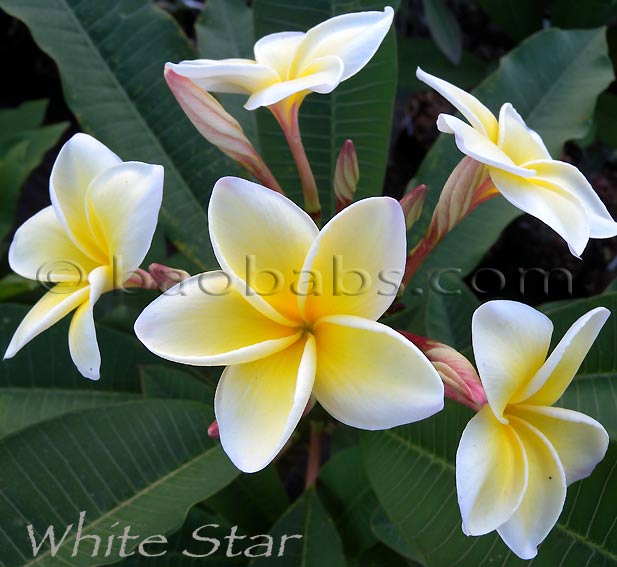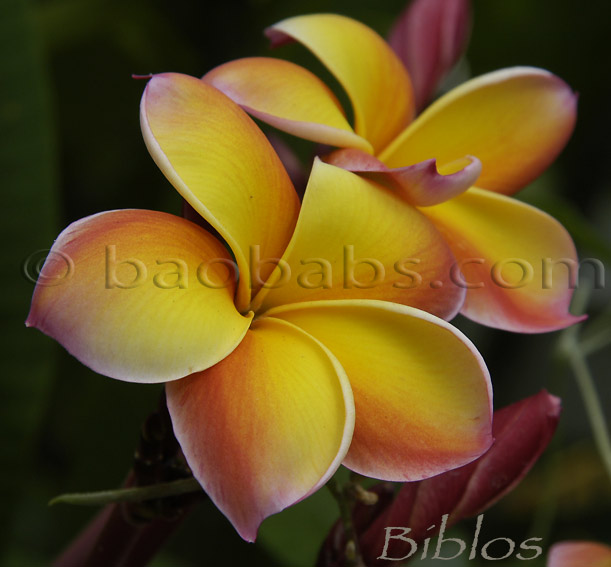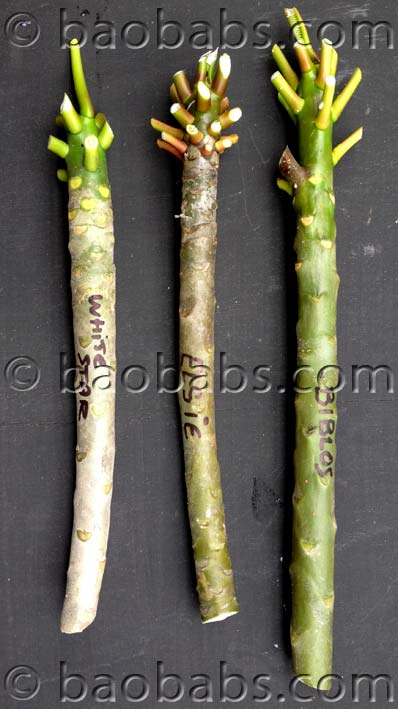
At Le Jardin Naturel, we cultivate Plumeria (frangipani) for more than 20 years. Now at least 250 different cultivars are planted in the garden and several hundreds are cultivated in pots within the nursery. We export seeds, plants, and cuttings all over the World. Please take a look to the other pages devoted to Frangipani.
![]() SEEDS, PLANTS AND CUTTINGS FOR SALE :
SEEDS, PLANTS AND CUTTINGS FOR SALE : ![]() SEE HERE
SEE HERE
Nothing evokes that tropical feeling quite like the frangipani. Their sweet scent and sheer beauty make them universally loved and the blooms look sensational on the tree and as a cut flower. Pick up some freshly fallen blooms and float them in a bath or bowl of water and it's easy to feel you're relaxing in a fabulous tropical day spa!
Most familiar in their white and yellow form, they also come in loads of tropical and sunset colours, becoming more colourful the closer to the equator you go.
Frangipanis are also tough plants that can survive neglect, heat and drought (but not to severe frost) and still fill the garden with a wonderful perfume.
What more could you ask for in a tree?
HISTORY OF THE FRANGIPANI (PLUMERIA)
The name "Plumeria" is attributed to Charles Plumier, a 17th Century French botanist who described several tropical species, although according to author Peter Loewer, Plumier was not the first to describe Plumeria. That honour goes to Francisco de Mendoza, a Spanish priest who did so in 1522

The name, frangipani, comes from the Italian nobleman, Marquis Frangipani, who created a perfume used to scent gloves in the 16th century. When the frangipani flower was discovered its natural perfume reminded people of the scented gloves, and so the flower was called frangipani. Another version says that the name, frangipani, is from the French "frangipane" which is a type of marzipan, which reminds the scent of the Plumeria.
![]() SEEDS, PLANTS AND CUTTINGS FOR SALE :
SEEDS, PLANTS AND CUTTINGS FOR SALE : ![]() SEE HERE
SEE HERE
GENERALITIES ABOUT FRANGIPANI (PLUMERIA)
Frangipanis are relatively small trees growing only to about 5-6m in height, but what they lack in height they make up in width often becoming as wide as they are tall. They have a well-behaved root system which makes them great for the home garden and for growing in pots. Frangipanis are also great survivors coping with drought, heat, neglect and insect and pest attack. They are also deciduous allowing maximum winter sun while providing shade in summer.

With its gnarled branches, long leaves and distinctive flowers, the frangipani is easily one of the most common and identifiable trees. The bark is grey/green and scaly in appearance. The scaling is formed when leaves drop in winter leaving small semi-circular marks on the bark. The branches have a swollen appearance and the leaves, dark green on the top and a lighter shade of green underneath, cluster at the tips of branches. A cut made on any part of the tree will exude a milky, sticky sap that is poisonous to both humans and animals.
Frangipani flowers appear in clusters, also at the end of the branches, and are distinctively scented. The petals are waxy with the centre of the flower generally a different colour to the rest. For example the most common frangipani has white flowers with a yellow centre most commonly named Celadine or White Star. There are many cultivars (often called 'varieties') ranging from deep crimson to orange , yellow and white (and every shade in between). Unlike some flowering trees which bloom for a few days or weeks, frangipanis go on flowering. Flowers appear after a period of dryness, and generally during the first weeks of the hot and raining season.
![]() SEEDS, PLANTS AND CUTTINGS FOR SALE :
SEEDS, PLANTS AND CUTTINGS FOR SALE : ![]() SEE HERE
SEE HERE
THE DIFFERENT SPECIES AND CULTIVARS (VARIETIES) OF FRANGIPANI
Plumeria (common name Frangipani) is a small genus of 7-8 species native to Mexico, Tropical America and the Caribbean. The genus consists of mainly deciduous shrubs and trees. From Mexico and Central America, Plumeria has spread to all tropical areas of the world.

Plumeria is related to the Oleander (Nerium oleander) and both possess poisonous, milky sap, rather similar to that of Euphorbia. Each of the separate species of Plumeria bears differently shaped leaves and their form and growth habits are also distinct.
Plumeria Obtusa is a mainly evergreen tree (decidous in dry seasons) with spreading branches and a rounded dome. Although its common name is "Singapore", it is originally from Colombia. Height to 8m and spread to 4m. Leaves are pointed and oval up to 18cm long. Tubular fragrant flowers occur in summer - autumn.

Plumeria rubra (and variation Plumeria acutifolia) also known as the Common Frangipani or Red Frangipani, is native to Mexico, Central America, and Venezuela. It is a decidous, spreading, sparsely branched tree or shrub with a height to 4m and spread to 4m and more. Produces fragrant flowers with 5 spreading petals, ranging from white and yellow to pink depending on form or cultivar, in summer to autumn. Leaves are lance shaped to oval, and 20cm to 30cm long.
Other species of Plumeria: Plumeria pudica, Plumeria stenophylla (filifolia), Plumeria cubensis, Plumeria caracasana, Plumeria portoricensis, Plumeria subsessilis, etc.
![]() SEEDS, PLANTS AND CUTTINGS FOR SALE :
SEEDS, PLANTS AND CUTTINGS FOR SALE : ![]() SEE HERE
SEE HERE
PROPAGATING FRANGIPANI (PLUMERIA) BY SEEDS
When propagating by seed, the results can be a little unpredictable. You will get a plant bearing some resemblance to its parent, but it is unlikely to be an exact duplicate. It usually takes three years or so before your new plant blooms, whereas with plant propagation from cuttings you should see your new frangipani flowers in the first year.

Minimum temperature should be at least 18C. Simply place your seeds into the pot, ensuring the soil stays slightly moist until your seedlings appear, which may take up to a fortnight.
PROPAGATING FRANGIPANI (PLUMERIA) BY CUTTINGS

Propagation by cuttings takes the guesswork out of it - your new frangipani will be an exact duplicate of the parent plant.
Cuttings should be a minimum of 10cm (4") in length.
You can leave the cutting aside for at least five weeks, ideally in an upright position in a dry location.

The technique of rooting frangipani is very simple.
Success depends on two essential parameters: temperature and structure of the substrate in which the cuttings are placed.
- Placement:
You need to support your frangipani with a stake or ropes for a few weeks until the roots anchor it firmly in position.
Do not sink too deeply the cutting because the roots appear only on the cut surface (see photo below) and this could promote rotting. In this case it is advised to stake the cutting, so it does not move or fall.
The ideal is that the cutting is simply placed in contact with the substrate held by tutors and not to fall or move until the roots are not developed.
- Temperature: root development will be even faster than the temperature will be close to ideal conditions, around 30-32 ° C during the day. Below a minimum estimated at approximately 20 ° C, the cuttings will have trouble to produce roots.
Water once every few weeks if the soil is dry, otherwise leave them alone until new leaves appear.

When new leaves appear or when the roots appear at the bottom of the pot, cuttings can then be transplanted into a more nutritious media.
Potting Media: When the cutting is firmly rooted, it is ready to be transplanted into a richer media. The roots will be brittle and the cutting must be un-potted gently in order to avoid breakage. Plumeria are not particular in regards to the exact composition of the potting media, but two requirements must always be kept in mind when mixing the media:(1) the media must have excellent drainage, and (2) the media should be rich in nutrients. Examples of suitable mixes:
(a) 1/4 Perlite, 1/4 Coir or peat moss, 1/4 composted Steer manure or compost, 1/4 pumice or fine lava rock.
(b) 1/2 Sunshine mix #4, 1/4 composted Steer manure or compost, 1/4 pumice or fine lava rock.
(c) 3/4 commercial Cactus mix, 1/4 manure or compost.
Note: A small amount of horticultural charcoal can be added to any of the above mixes in order to improve drainage. Also, after a sufficient amount of media has been placed in the bottom of the pot, 2-3 tablespoons of bone meal or blood meal can be mixed into this media before the rooted plumeria is placed in the pot.

![]() SEEDS, PLANTS AND CUTTINGS FOR SALE :
SEEDS, PLANTS AND CUTTINGS FOR SALE : ![]() SEE HERE
SEE HERE
GROWING FRANGIPANI (PLUMERIA)
Frangipanis will grow well in any soil type but prefer a well drained soil. They will grow in all climates except the severe frost prone temperate climates, however, they prefer and grow best in a hot dry climate. They are very drought and fire hardy.
Plumeria rubra LJN CELINE
Growing position :
being a tropical plant, the frangipani prefers to grow in full sun and well-drained soil. It will tolerate part shade, but those grown in a warm to hot position where they get at least 6 hours of sun a day will grow faster and flower far better than those grown in part shade. They can cope with sea breezes but prefer protection from high winds. Frangipanis will tolerate light frosts, but in cooler climates give them the warmest, sunniest spots in the garden or move them to a warm protected area in late autumn. A hot house is ideal, but placing your frangipani on a concrete path against a brick wall where it will get radiated heat (and be protected from frost and wind) will also work.
Growing in containers :
Frangipanis are also perfectly adaptable to growing in containers. Because they respond well to pruning, they're easy to keep under control. Choose a large container with a diameter of at least 40cm and plenty of volume. If over time the tree becomes pot-bound, lift it out and prune back the roots before re-potting into fresh potting mix.
Watering:
Over-watering is a common mistake when growing plumeria. Although the plants have a lush, tropical appearance, plumeria culture is similar to cactus cultivation rather than tropical houseplants. When in doubt, don't water. A thirsty plumeria will quickly recover, but a plant afflicted with rotting roots due to over-watering can be difficult to salvage. During the growing season, a once-weekly watering is usually sufficient, unless the plant is pot-bound. The media should be allowed to dry out slightly between waterings.
Fertilising :
Bonemeal, bloodmeal, and/or organic manures should be added to the media.
Feed them occasionally with a soluble fertiliser and remember that potted plants need more frequent watering than those in the ground. Water moderately in summer, especially when the trees are young and becoming
established. Old established trees can
survive quite happily on natural rainfall. During winter, when the trees are bare, leave the watering to nature. Frangipani will not tolerate its root system being over wet and cold at the same time, and rot may develop!
Frangipani respond best to organic fertilizers which are high in nitrogen, potassium (or potash) and phosphorous.
Nitrogen is good for green growth, phosphorous for large flowers and healthy roots, and potassium or potash for good plant cell structure and strength, as well as improving disease resistance.
During the growing season, an application of liquid fish fertiliser and seaweed solution is beneficial. Do not fertilise during dormancy.
Mulching
the soil around the tree will keep the roots cool in summer and warm in winter. It also helps to retain moisture and reduce weeds however mulch should be kept away from the trunk to avoid rot.
Pruning :
Frangipanis respond very well to pruning. Different pruning approaches can be used to create a compact, densely branched tree or a standard with long trunk and no lower branches. However, be aware that frangipani flowers appear only at the end of branches, and these must be two years old before they bloom. So, if you plan to prune your frangipani heavily, consider doing half one year, and then half the next year to ensure a continous display of flowers.
To create a densely branched specimen prune branches to one half or one third of their natural length. These pruned branches will sprout multiple branches near the pruned ends.
To prune to produce a standard, simply prune branches right back to the main trunk so that no further branching can occur.
Pruning is best done during late winter or early spring.
Dormancy & Winter Care:
Although there are evergreen varieties of plumeria (ie: 'Singapore White'), most varieties are deciduous. Under temperate climates, plumerias will usually drop their leaves early in autumn. This dormant period helps to trigger flower bud production in the following spring. Dormant plumeria do not require watering, but it may be necessary to occasionally mist the trunk due to the lower humidity of household air over the winter. Plumerias placed in the kitchen or bathroom may not need misting as the higher humidity of these rooms will help prevent desiccation of the trunk. Plumerias should be kept at a temperature of not less than 10 Celsius during the dormancy period.
![]() SEEDS, PLANTS AND CUTTINGS FOR SALE :
SEEDS, PLANTS AND CUTTINGS FOR SALE : ![]() SEE HERE
SEE HERE
